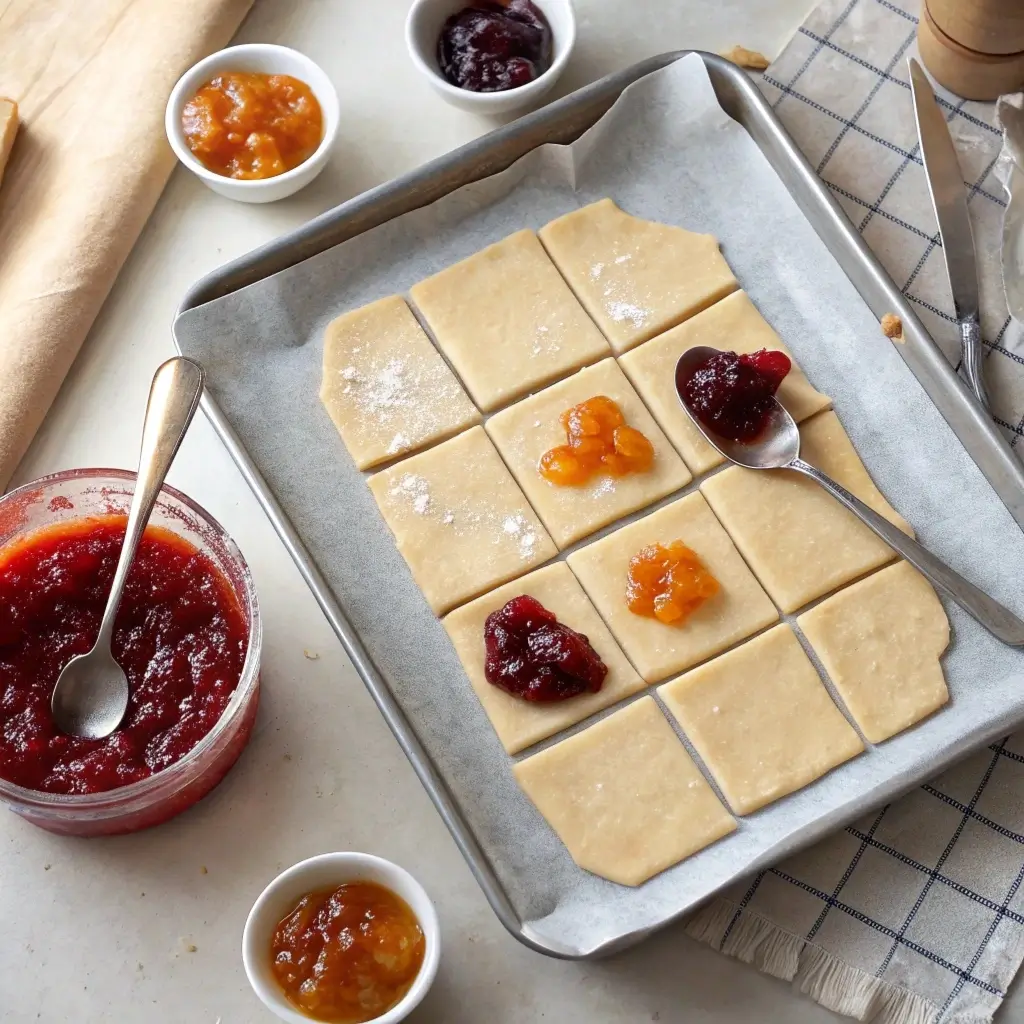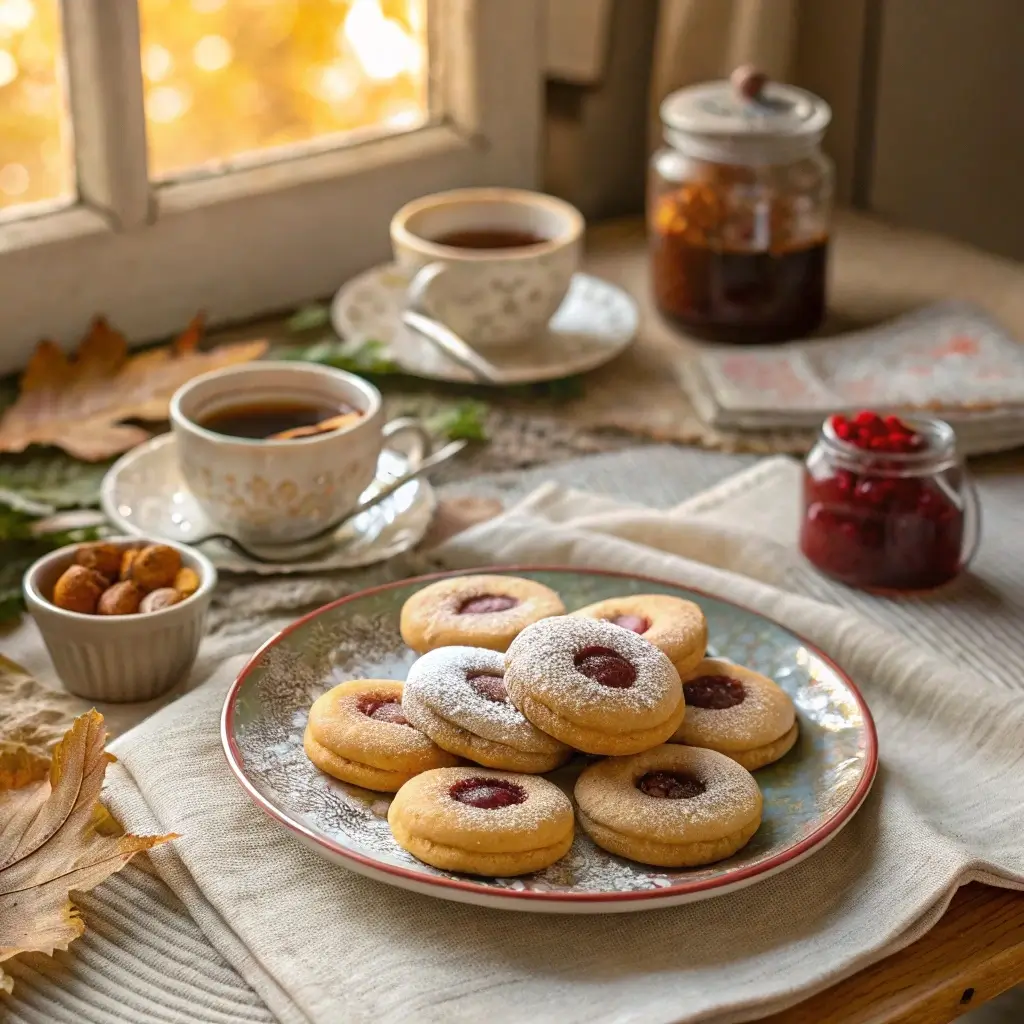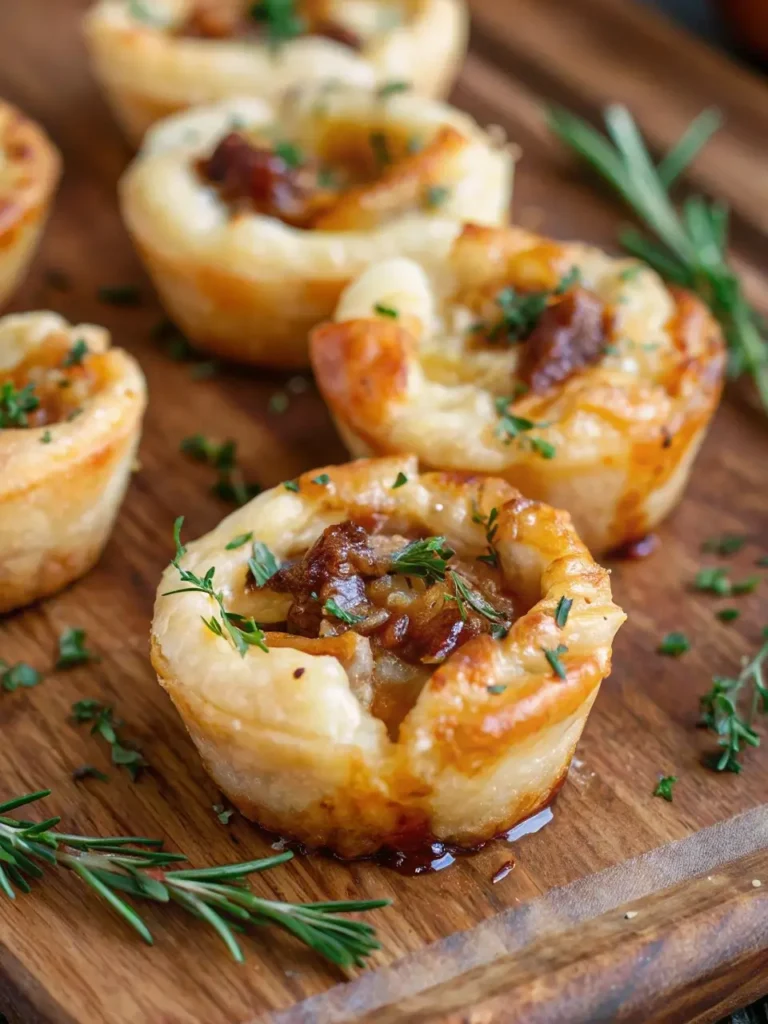There’s something magical about recipes passed down through generations—especially when they come wrapped in flaky dough, filled with homemade jam, and dusted with powdered sugar. That’s exactly what kolache cookies offer: a sweet bite of heritage, nostalgia, and old-world charm.
These delicate cookies have become a holiday staple in many American households, especially in families with Polish, Czech, or Slovak roots. But despite their old-fashioned name and European origin, kolache cookies are easy to love—and even easier to make.
In this article, we’ll explore where kolache cookies come from, how they differ from other pastries, and why they remain one of the most treasured cookies across Central and Eastern Europe. Plus, you’ll get a full step-by-step recipe and answers to the most common kolache cookie questions.
Looking for inspiration beyond cookies? Don’t miss our Cottage Cheese Chocolate Pudding—a smooth, protein-packed dessert that pairs perfectly with jam-filled sweets like kolaches.
What Are Kolache Cookies? A Delicious Introduction
🍑 The Beauty of Jam-Filled Heritage Cookies
Kolache cookies are buttery, soft, and slightly crisp at the edges. Their signature feature? A sweet fruit or nut filling nestled in the center, folded or pressed into the dough. Most commonly, you’ll see apricot, raspberry, or prune jam, though modern versions use cream cheese, poppy seed, or even chocolate.
These cookies are often served during Christmas, Easter, and weddings—though many families enjoy them year-round with tea or coffee.
🧡 What Makes Kolache Cookies So Unique?
- They’re rolled, cut, and filled—not dropped or scooped
- They balance rich, buttery dough with tangy, fruity fillings
- They look elegant yet rustic, with old-world charm
- They’re deeply cultural, tracing back to Czech and Slovak roots
Kolache cookies aren’t just dessert—they’re a story baked into dough. They speak of family, celebration, and a simpler time when recipes were handwritten on cards and passed from grandmother to grandchild.
Kolache Cookies and Their Cultural Roots
🌍 What Nationality Is a Kolache Cookie?
Kolache cookies, also called kolacky or koláče in Europe, are traditionally found in the baking traditions of Czechia, Slovakia, and Poland. The name comes from the Slavic word kolo, meaning “circle” or “wheel”, which makes sense considering the round, filled shape of the cookie.
In the U.S., these cookies are especially popular in communities with Czech or Polish heritage—you’ll find them served at weddings, holidays, and cultural festivals from Texas to Chicago. While many think of kolache as just cookies, the word can also refer to yeast-based pastries and even bread rolls with savory fillings.
But when it comes to kolache cookies, we’re talking about a sweet, shortbread-style or cream cheese dough, filled with fruit preserves or cheese, and dusted with powdered sugar. These aren’t your everyday cookies—they’re a cultural experience in every bite.
🇨🇿 Are Kolaches Polish or Czech?
The answer? Both—and more.
Kolaches likely originated in Czech and Slovak regions, where versions of the pastry have been baked since the 1700s. In Czech culture, koláče are traditional pastries often made with yeasted dough and filled with sweet cheese, poppy seed, or jam. The cookies we know today evolved from these larger pastries, adapted into bite-sized, buttery versions that became popular in Polish-American baking.
In Polish-American communities, they’re often called kolaczki or kolacky cookies, made with sour cream or cream cheese dough, and typically folded into squares or rounds. The name changes slightly across cultures, but the idea is the same—delicate, buttery dough wrapped around a sweet center.
Fun fact: In Texas, Czech immigrants introduced yeasted kolaches, which evolved into both sweet and savory versions—some filled with sausage or jalapeño—but that’s not the same as the cookie-style kolache we’re covering here.
🇩🇪 Are Kolaches a German Thing?
While kolache cookies are often confused with German or Austrian pastries (like danishes), they are not traditionally German. However, due to cultural overlap and immigration patterns in the Midwest and Texas, German communities may also bake them or serve similar-looking desserts.
Still, the roots of kolache cookies are solidly Central European, with Czech and Polish heritage at the heart of the tradition.
Kolache vs Kolacky – What’s the Difference?
📣 How Do You Pronounce Kolacky Cookies?
Depending on your background or where you live, you might hear these sweet pastries called:
- Kol-AH-chee
- Ko-LOTCH-kee
- Kol-atch-key
- Even kolache, kolacky, or kolaczki
In Czech, the plural form is koláče (koh-LAA-cheh), while in Polish it’s often kołaczki or kolaczki (koh-WAHTCH-kee). In the U.S., the spelling and pronunciation have been Americanized, especially in communities with Central European roots.
No matter how you say it, one thing’s certain: these cookies are buttery, fruity, and melt-in-your-mouth delicious.
🥐 What the Heck Is a Kolache, Anyway?
Let’s break it down.
- In its original Czech form, a kolache (koláč singular) was a round, yeasted pastry with fruit, poppy seed, or cheese filling.
- In Polish-American bakeries, they became folded cookies, made from cream cheese or sour cream dough and filled with sweet jam.
- In modern Texas, “kolaches” often refer to savory pastries filled with sausage—more like a pig in a blanket.
This mix of traditions has created confusion, but for the purpose of this article—and what most Americans mean when they search for “kolache cookies”—we’re talking about the sweet, fruit-filled cookies made with rich dough and baked on a tray.
🥖 Are Kolaches and Pigs in a Blanket the Same Thing?
Not even close—but the mix-up is understandable.
In Texas and parts of the Midwest, the term “kolache” has come to mean any baked dough with filling—including savory sausage-filled rolls wrapped in bread dough. These are actually klobasnek (the correct Czech term for savory kolache-like buns), but the name “kolache” stuck.
So, to clarify:
| Item | Sweet or Savory | Dough Type | Common Filling |
|---|---|---|---|
| Kolache Cookie | Sweet | Shortbread/Cream Cheese | Fruit preserves, cheese |
| Traditional Kolache | Sweet | Yeasted | Poppy seed, jam, sweet cheese |
| Texas Kolache (Klobasnek) | Savory | Yeasted bread dough | Sausage, jalapeño, cheese |
If you’re here for soft, buttery cookies filled with jam—you’re definitely in the kolache cookie camp.
What Goes into Authentic Kolache Cookies?
🧈 Classic Dough and Traditional Fillings
At the heart of every delicious batch of kolache cookies is the dough—a rich, buttery base that’s soft but holds its shape, delicate but sturdy enough to carry a sweet filling. Traditional recipes vary slightly by region, but most use a few key ingredients:
Classic Kolache Cookie Dough Includes:
- All-purpose flour – the base of the dough
- Unsalted butter – for richness and flakiness
- Cream cheese or sour cream – for soft, tangy structure
- Egg yolks – to bind and enrich
- Granulated sugar – lightly sweetens the dough
- Salt – to balance the sweetness
- Optional: vanilla extract or lemon zest for extra flavor
The dough is chilled, rolled out thin, and cut into rounds or squares, then filled and folded or pressed depending on the style (Czech, Polish, Slovak).
🍓 Traditional Fillings for Kolache Cookies:
- Apricot jam – tangy, bright, and classic
- Prune butter (lekvar) – deep, sweet, and very old-world
- Raspberry or cherry preserves – popular holiday choices
- Sweet cheese filling – made from ricotta, farmer’s cheese, or cream cheese
- Poppy seed paste – a Czech-Slovak staple
These fillings aren’t just flavor—they’re cultural markers, passed down through generations.
🍒 Modern Twists: New Flavors and Dough Variations
As kolache cookies have made their way into more American kitchens, creative bakers have introduced modern variations. While purists may stick to prune and apricot, new twists have helped keep the tradition alive.
✨ Modern Filling Ideas:
- Strawberry and cream cheese
- Nutella or chocolate hazelnut spread
- Almond paste or chopped walnuts with honey
- Apple pie filling with cinnamon
🌀 Dough Variations:
- Gluten-free flour blends for dietary needs
- Vegan butter and dairy-free cream cheese
- Lemon zest or almond extract added to the dough for a flavor boost
Whether you go old-school or reinvent the wheel, the essence of kolache cookies stays the same: a flaky, rich dough wrapped around something sweet and homemade.
Want something to serve with your kolaches? Try our Cheese Omelette Recipe—it’s light, savory, and balances sweet cookies perfectly for brunch or holiday spreads.
How to Make Kolache Cookies – Step-by-Step Recipe
Kolache cookies may look fancy, but they’re surprisingly simple to make once you understand the dough and filling process. This easy recipe yields buttery, tender cookies with your choice of jam, cheese, or nut fillings—and they’re perfect for holidays, tea parties, or gifting.
🍽️ Ingredients for Classic Kolache Cookies
For the Dough:
- 2 cups all-purpose flour
- 8 oz (1 cup) cold unsalted butter, cut into cubes
- 8 oz (1 cup) cream cheese, softened
- 2 tablespoons granulated sugar
- ½ teaspoon salt
- Optional: 1 teaspoon vanilla extract or ½ teaspoon lemon zest
For the Filling:
- ½ cup fruit preserves (apricot, raspberry, prune, cherry, etc.)
- OR ½ cup sweetened cream cheese filling
- Optional: poppy seed or nut filling
To Finish:
- ¼ cup powdered sugar, for dusting after baking

👨🍳 Instructions – Rolling, Filling & Baking Like Grandma Did
- Make the Dough:
In a large bowl (or food processor), combine the flour, sugar, and salt. Cut in cold butter and cream cheese until the mixture comes together into a soft dough. Add vanilla or lemon zest, if using. - Chill the Dough:
Divide the dough in half, wrap in plastic, and chill for at least 1 hour (or up to overnight). Chilling helps firm up the dough for easy rolling. - Preheat Oven:
Preheat your oven to 375°F (190°C) and line two baking sheets with parchment paper. - Roll & Cut:
On a lightly floured surface, roll one dough portion to about ⅛ to ¼ inch thick. Cut into 2 to 2.5-inch squares or circles using a cookie cutter or knife. - Add Filling:
Place ½ teaspoon of filling in the center of each piece. Don’t overfill—less is more to prevent leaking. - Shape the Cookies:
- For square shapes: fold two opposite corners toward the center and pinch gently to seal.
- For round shapes: press a dent in the center and spoon jam inside.
- Bake:
Transfer to baking sheets and bake for 12–15 minutes, or until edges are just turning golden. - Cool & Dust:
Let cookies cool on the pan for 5 minutes, then transfer to a wire rack. Once fully cooled, dust generously with powdered sugar.
✅ Tips for Better Kolache Cookies
- Chill dough thoroughly to keep it from sticking and spreading
- Use thick preserves or lekvar (prune paste) for best filling results
- Avoid overbaking—kolache cookies should be lightly golden, not browned
- Store in an airtight container at room temp for 3 days or freeze for up to 1 month
- To serve later, just thaw and redust with powdered sugar
FAQs About Kolache Cookies
Even with a great recipe, there are always a few questions that pop up when making or serving kolache cookies—especially since they come from a mix of Polish, Czech, and American traditions. Here are some of the most common ones, answered simply.
❓What’s the Difference Between Kolaches and Kolaczki?
The difference is mostly in the name and spelling, based on region and language.
- Kolaczki is the Polish spelling
- Kolacky is an Americanized form
- Kolache (or koláče) is Czech or Slovak
In practice, they all refer to jam-filled cookies made with a buttery or cream cheese dough—especially during the holidays.
❓Are Kolache Cookies Sweet or Savory?
Kolache cookies are always sweet.
They’re made with rich dough and filled with fruit preserves, sweet cheese, or poppy seed paste.
Confused with savory kolaches (like sausage rolls in Texas)? Those are actually a different thing—technically called klobasnek—and not the dessert-style kolache cookies featured here.
❓Can You Freeze Kolache Dough or Baked Cookies?
Yes, and that’s what makes them a great make-ahead cookie.
- Freeze the unbaked dough (wrapped tightly) for up to 2 months
- Freeze baked cookies without powdered sugar for up to 1 month
- To serve later: thaw, bake or warm, then dust with fresh sugar
❓Do Kolaches Always Contain Fruit?
Traditionally, yes—but not only fruit.
While apricot and prune are classic, kolache cookies also come filled with:
- Sweetened cream cheese
- Poppy seed paste
- Finely ground walnuts or pecans mixed with sugar and spice
- Even raspberry jam or cherry preserves in modern versions
You can get creative with fillings—but sticking to thicker, not-too-wet options helps keep the cookie shape.

Conclusion – Preserving a Delicious Tradition
Kolache cookies aren’t just about butter and jam—they’re about heritage. Every fold of dough and spoonful of sweet filling tells a story passed down from grandmothers, great-aunts, and generations who baked before us. Whether you call them kolacky, kolaczki, or just “those jam cookies Grandma made,” they’re a reminder that food can carry culture, love, and memory.
What makes kolache cookies so timeless?
They’re simple to make, endlessly customizable, and perfect for celebrating any occasion—Christmas, Easter, weddings, or just a quiet afternoon with coffee.
By learning how to make kolache cookies at home, you’re not just baking—you’re keeping a tradition alive. You’re creating new memories while honoring old ones. And that’s what the best recipes do.
📌 Want more traditional treats and inspiration?
Follow us on Pinterest for more Eastern European recipes, heritage cookies, and cozy baking ideas:
🔗 https://www.pinterest.com/RecipesFaza/
Kolache Cookies – 7 Irresistible Facts About This Sweet Tradition
Tender, buttery kolache cookies made from a rich cream cheese dough and filled with traditional fruit preserves like apricot, raspberry, or prune. A Central European holiday favorite passed down through generations.
- Prep Time: 20 minutes
- Cook Time: 15 minutes
- Total Time: 1 hour 35 minutes
- Yield: 24 cookies 1x
- Category: Cookies, Dessert
- Method: Baked
- Cuisine: Central European
- Diet: Vegetarian
Ingredients
For the Dough:
2 cups all-purpose flour
8 oz cold unsalted butter, cubed
8 oz cream cheese, softened
2 tbsp granulated sugar
½ tsp salt
1 tsp vanilla extract (optional)
For the Filling:
½ cup thick fruit preserves (apricot, raspberry, prune, or cherry)
OR ½ cup sweetened cream cheese
To Finish:
¼ cup powdered sugar, for dusting
Instructions
In a large mixing bowl, combine flour, sugar, and salt.
Cut in butter and cream cheese using a pastry cutter or hands until dough forms.
Add vanilla if using. Divide dough in two, wrap, and chill for 1 hour.
Preheat oven to 375°F (190°C). Line baking sheets with parchment.
Roll dough to ¼ inch thick. Cut into 2–2.5″ squares or circles.
Add ½ tsp jam or filling to center. Fold opposite corners or leave open.
Bake for 12–15 minutes until edges are lightly golden.
Cool completely. Dust with powdered sugar before serving.
Notes
Chill dough thoroughly for easier rolling and shaping.
Use thick jam or lekvar (prune paste) to prevent spreading.
Avoid overbaking to keep cookies tender, not crisp.
Store in airtight container for 3–4 days or freeze unbaked dough.
Nutrition
- Serving Size: 1 cookie
- Calories: 110
- Sugar: 4g
- Sodium: 45mg
- Fat: 7g
- Saturated Fat: 4g
- Unsaturated Fat: 2g
- Trans Fat: 0g
- Carbohydrates: 11g
- Fiber: 0.5g
- Protein: 1g
- Cholesterol: 20mg




